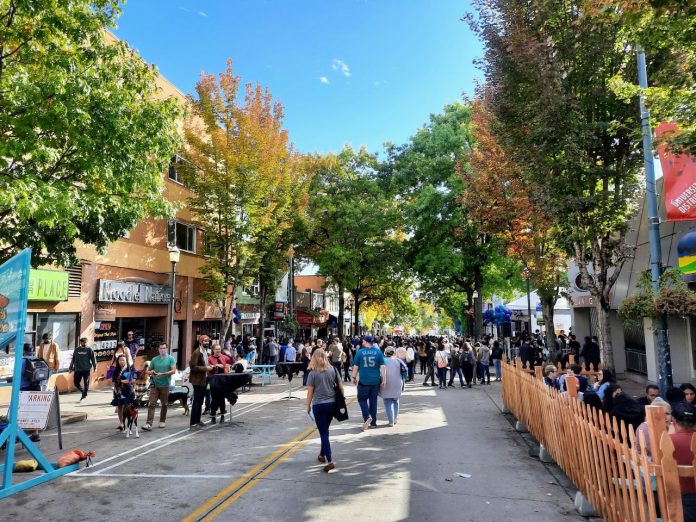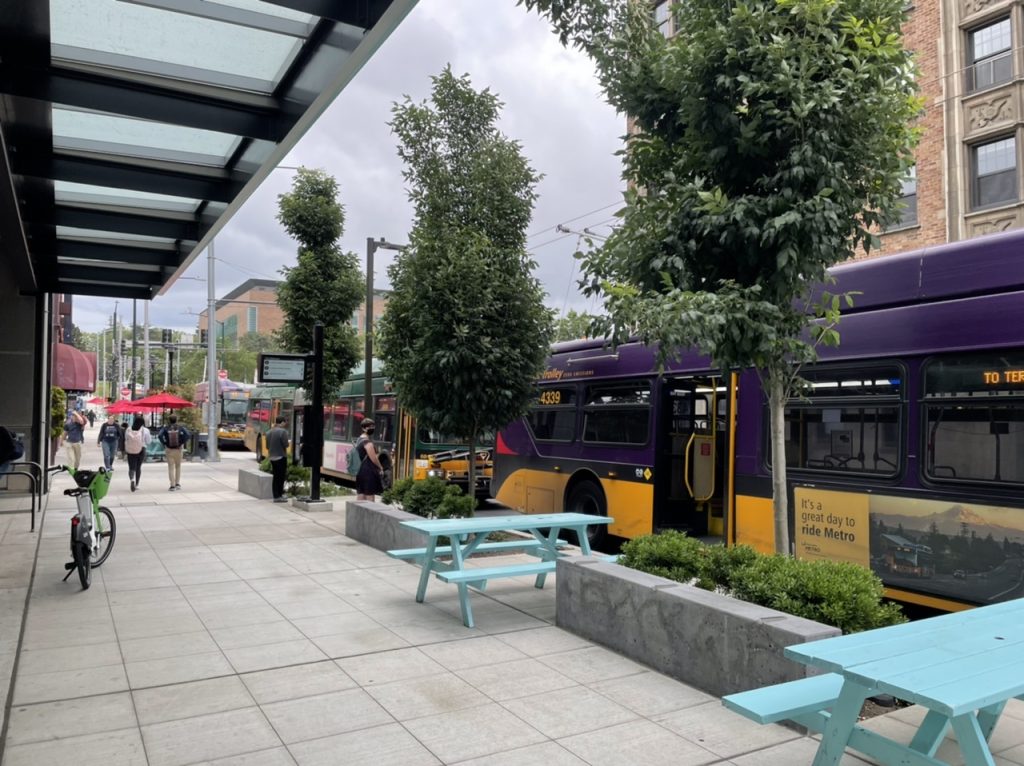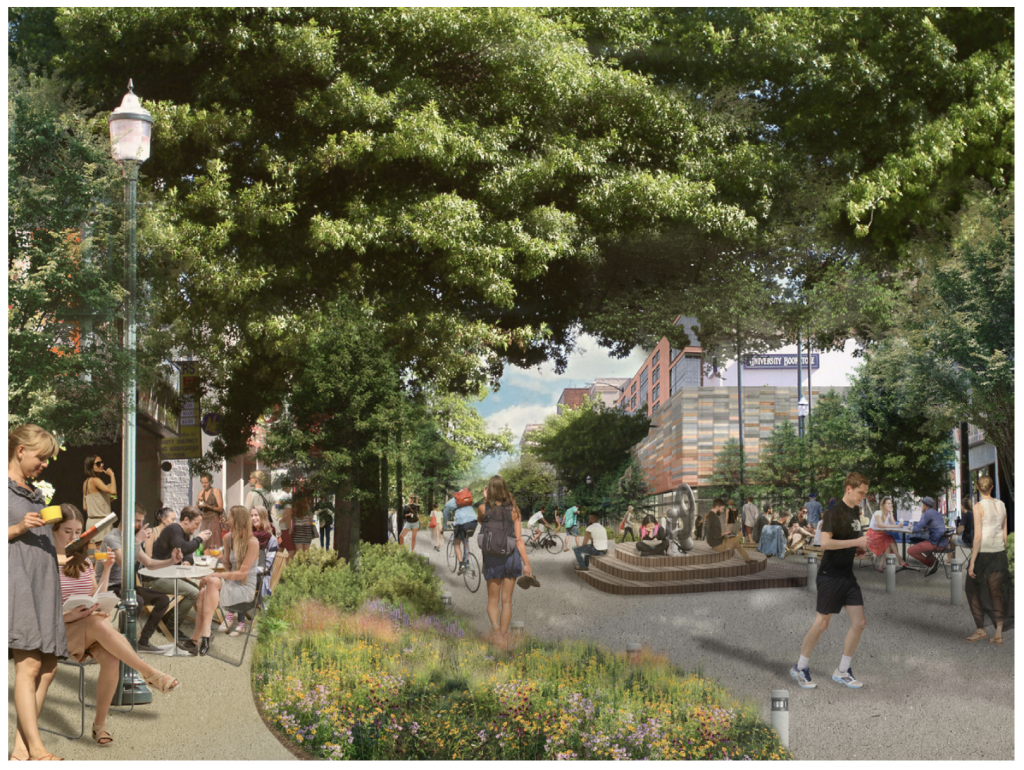
A UW student is seeking to spark a conversation about finally pedestrianizing The Ave after decades of dreaming.
On Thursday, April 3rd, around 60 U District residents filed into University of Washington (UW)’s Gould Hall for the “A Car-Free Ave?” event, put on by Community, Environment, & Planning (CEP) major Jaykub Rafael for his senior capstone. Students and retirees alike clustered around eight tables to discuss their visions for a pedestrianized University Way or colloquially just “The Ave,” from yoga classes to a daily market.
“The goal of this project isn’t to make specific redesigns of The Ave, ’cause we already have that,” Rafael explained in a phone interview. “The goal also isn’t to convince people, because we have studies that say pedestrianization is beneficial to a community. But we don’t have a community that wants to support the project. In order to gain this community support, our projects should reflect the identity of the community, and that’s what my vision is, to start this conversation of: What do we want to see?”
The Ave, which is accessible by light rail and largely patronized by students who live nearby, is ripe for pedestrianization. A popular Reddit post called the street “undesirable to drive on” given its limited parking and lack of passing lanes. Most pedestrianization plans would allow delivery trucks while rerouting buses to 15th Avenue NE.

Back in the ’50s, architect and Pike Place savior Victor Steinbrueck proposed turning the street into an outdoor mall. In 1971, a similar plan drew support from UW and the local chambers of commerce but crumbled due to backlash from property owners, particularly the powerful parking association.
Doug Campbell, who founded The Ave’s iconic cafe and magazine store Bulldog News in 1983, is a longtime supporter of pedestrianization. He even suggested that we conduct our interview in the recently installed parklet in order to witness the disruption of traffic.
Recalling the fights of 1971, Campbell said, “They thought it would become a hippie haven. There was definitely a fight between the merchants and the hippies in those days.”
Campbell notes that many Ave business-owners are wary of losing customers because of pedestrianization. He proposes that we better utilize our preexisting parking, perhaps by opening up the University-owned parking garages beneath Red Square and by the UW Tower to non-faculty on weekends.
“If you’re trying to cut a deal that says, ‘Okay, we’re going to take all this parking off The Ave,’ it might be good to have some alternatives for people who are trying to run businesses that depend on automobiles. I’d support it with or without a garage, but if you’re talking about my neighbors and the political situation, some kind of parking is necessary,” Campbell said.
Nonetheless, the Overton Window seems to be edging towards pedestrianization.
Back in 2018, a design proposal put forth by the U District Mobility Group sparked a flurry of pro– and anti-pedestrianization articles, including an op-ed from UW’s The Daily citing concerns about gentrification.
“It was a big, like, What? How did you reach this point?” recalls Rafael. “In my mind, [pedestrianization] is giving space to community members. But then I looked at the design, and it was almost like they were making U Vill but for The Ave . . . If the community were actually involved in the planning of this space, maybe we can reach designs that people would actually want to see.”
Fast forward two years, and the pandemic shifted the conversation once again. Outdoor dining and streateries arose out of necessity, but stuck around thanks to their popularity. As parks and other public spaces provided refuge from people’s bedrooms, urbanism grew in popularity, with mainstream outlets like The Atlantic taking notice.
The high turnout at the “A Car-Free Ave?” event, held on a school night and largely advertised via flyers, speaks to increasing awareness, too. Ideas about opening The Ave up to street performances, greenery, community centers, and artisan vendors harken back to visionary Steinbrueck, who was fond of this Lewis Mumford quote: “Plan our cities for lovers and friends and forget about the damn motor car.”
If you’d like to get involved, make your opinion known to the U District Community Council, which meets the second Wednesday of every month at 7pm at Bulldog News. You can also get plugged in to the U District chapter of Seattle Neighborhood Greenways, which has advocated for a pedestrianized Ave.

Alison Jean Smith
Alison Jean Smith is the Local Sightings Director at Northwest Film Forum, a member of the TeenTix Alumni Advisory Board, and a contributor to REDEFINE, an online magazine where she interviews both emerging and established filmmakers. She has also had her writing published in The Stranger, The South Seattle Emerald, and on the doubleXposure podcast website. Topics she’s covered range from wild horse training to debates over light rail. She is currently studying communication at the University of Washington.

